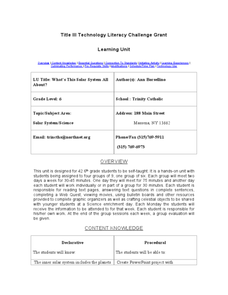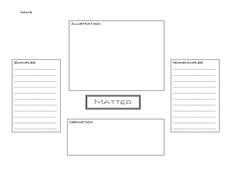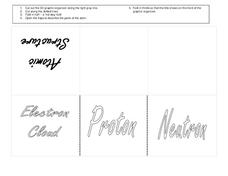Curated OER
What's This Solar System All About?
Sixth graders complete a unit of lessons on the solar system. In small groups, they participate in a Webquest, watch movies, complete graphic organizers, and answer questions, create a model of the planets, and develop a Powerpoint...
Curated OER
A Wild Family Album!
Young scholars create a scrapbook style family album for a selected animal. They complete an interactive Internet activity on research reports, fill out a graphic organizer, diagram a food web, and complete their scrapbook that includes...
Curated OER
Flow of Energy Through An Ecosystem
In this flow of energy in an ecosystem, students complete a graphic organizer and show the flow of energy from the sun to producers, primary consumers, secondary consumers, tertiary consumers and then decomposers. Students define each of...
Curated OER
Experimenting with Motion
Learners design an experiment to change the motion of a rolling marble. In this designing an experiment lesson plan, students form a research question, they develop a hypothesis and they design an experiment using a graphic organizer to...
Curated OER
States of Matter
In this states of matter worksheet, students will brainstorm and write down facts about solids, liquids, and gases in a graphic organizer.
Curated OER
What Are Reptiles, Amphibians, And Fish?
In this animal classification worksheet, students will compare and contrast the characteristics of reptiles, amphibians, and fish. This worksheet is a graphic organizer.
Curated OER
Traits
In this traits worksheet, students will complete a graphic organizer by filling in the definition and an example of inherited, learned, acquired, and manipulated traits.
Curated OER
Movements of Earth and the Moon
In this Earth and moon worksheet, students will read about how the Earth rotates on its axis and how the moon revolves around the Earth. Students will then write in the effect of these two movements. This worksheet is a graphic organizer.
Curated OER
Why Are Fossil Fuels Limited?
In this fossil fuels worksheet, students will determine why fossil fuels are a limited resource and brainstorm possible solutions. This worksheet is a graphic organizer.
Curated OER
How Can Renewable Energy Be Used?
In this renewable energy worksheet, students will write in details about the 4 types of renewable energy sources: solar, wind, moving water, and nuclear energy. This worksheet is a graphic organizer.
Curated OER
How Does the Sun Seem To Move?
In this sun worksheet, learners will fill in the blank of 3 statements about observing the movement of the sun. Then students will fill in the blank of a conclusion they develop from the facts. This worksheet is a graphic organizer.
Curated OER
Plants
In this plants worksheet, students will review the basic steps of photosynthesis, how materials are transported through a plant, and the process of plant reproduction. This worksheet is a graphic organizer.
Curated OER
Defense Against Infectious Diseases
In this infectious diseases worksheet, high schoolers read about the two types of defenses the body has against pathogens: innate (nonspecific) and adaptive (specific). Students then complete a graphic organizer by filling in 11 blanks.
Curated OER
Properties of Matter
In this properties of matter worksheet, students complete a graphic organizer that includes 2 types of matter, 2 examples of each type of matter and a description of each type.
Curated OER
Symbiosis
In this symbiosis worksheet, students complete a graphic organizer about the three types of symbiosis. They define commensalism, mutualism, and parasitism and list the important things to remember about each.
Curated OER
Transfer of Energy
In this transfer of energy worksheet, young scholars complete a graphic organizer that shows the relationship between the sun, producers, first order consumers and second order consumers. They describe why it is important to understand...
Curated OER
Matter
In this matter worksheet, students complete a graphic organizer for matter. They include examples, illustrations, non-examples and the definition.
Curated OER
The Atom
In this atom worksheet, students complete a graphic organizer for the structure of the atom. They include the definition of the mass number, the atomic mass, the atomic number, the protons, neutron and electrons.
Curated OER
The Atom
In this atom worksheet, students complete a 3 D graphic organizer for the structure of the atom. They define atomic structure, electron cloud, proton and neutron. They cut out the terms to make flaps with definitions.
Curated OER
Thinking about Erosion
In this erosion worksheet, students complete a graphic organizer about erosion. They include 4 reasons erosion occurs and they write about the consequences of erosion.
Curated OER
Experimental Research
In this experiment worksheet, students give examples of independent, dependent, and controlled variables. This worksheet is a graphic organizer.
Curated OER
DNA Technology
Pupils summarize their classmates' presentation in class. In this biology lesson, students create a graphic organizer based on concepts presented. They discuss and share their organizer.
Curated OER
Pumpkin Pumpkin
Students study the very basics of pumpkins. By looking at where pumpkins grow, what they grow on, and what can be done with a pumpkin. They create a graphic organizer and then carve a pumpkin for Halloween.
Curated OER
Which Baby Animals Looks Unlike Their Parents?
Learners review the steps of the butterfly life cycle to show how the babies are different from the parents. This learning exercise is a graphic organizer with four fill in the blank statements.

























